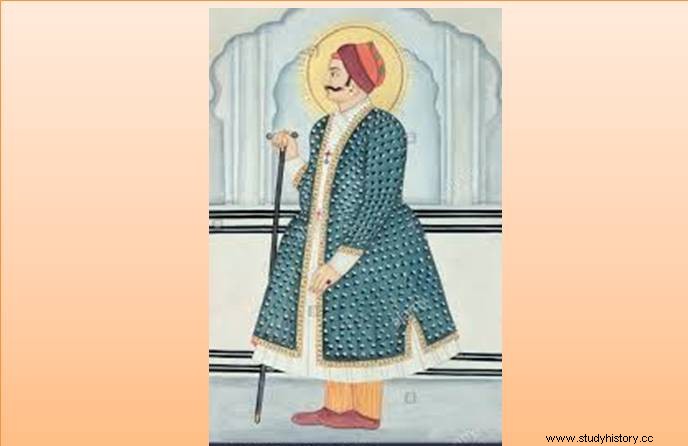
During the time when the responsibility of giving direction to the politics of North India came on the shoulders of Sawai Jai Singh, the whole country was stricken by the atrocities of Aurangzeb. During the 25 years spent by Aurangzeb on the southern front, the country's rich wealth was destroyed and lakhs of youths died. Agriculture was ruined. Cottage industries stopped getting raw materials. Commerce and trade came to a standstill as the roads became unsafe. Important activities like sculpture, architecture, painting were stopped. The work of singers, dancers and artists who were fed by performing various arts took off. The whole country was suffering from hunger, poverty and unemployment, after Aurangzeb the country came under the grip of conspiracies going on in the Mughal court. The drunken Marathas got an opportunity to raise their heads and set out to destroy the lush green plains of North India. Dreaded invaders like Nadir Shah used to come to Delhi and create massacres. The Mughal Subedars started establishing their independent kingdoms from place to place. The Hindu subjects were living a humble and helpless life in such terrible conditions.
Means of livelihood to the people
During that period the boys of Rajputs, Jats and Marathas were being killed in large numbers on the battlefields, so the means of subsistence for other castes became even more limited. In such difficult times, Jai Singh got the royal palaces, temples, dharamshalas, observatories, Jaipur city and some canals constructed to provide livelihood to the people. Millions of people got employment from these works.
liberation of people from jizya
Aurangzeb imposed Jizya tax on Hindu subjects. To avoid this, lakhs of Hindus renounced their religion and became Muslims. In 1713 AD, when Farrukhsiyar became the emperor, Jaziya was closed by asking Raja Jai Singh to stop it, but in 1717 AD, at the behest of Diwan Inayat Ullah, the jizya was resumed. In 1720 AD, Jaisingh requested Emperor Muhammad Shah to stop the jizya. Muhammad Shah accepted this prayer and the jizya was closed again.
Relief to the people from other taxes
In 1728 AD, Maharaja Jai Singh abolished the tax collected from the pilgrims of Gaya. On 4 June 1721, he got the practice of confiscating the religious places built by Mahants, Sanyasis and Bairagi mystics etc. after their death by issuing an order. Due to all these works, King Maharaja Jai Singh was highly praised all over the country.
Jai Singh's religious instinct
Jai Singh was a king of religious instinct. He was initiated into the well-known Nimbarka sect of Vaishnavas. For this reason he paid special attention to the study of Sanskrit. From time to time, he used to go for bathing in the Ganges and used to circumambulate the eighty-four kos. He used to keep Sitaramji's statue with him on the battlefield. A release published in the Calcutta Gazette states that Jaipur is the center of study of Hindu scriptures. It was from here that Colonel Nolier received copies of the Vedas and presented them to the British Museum. During the lifetime of Jai Singh, Jaipur was called Chhoti Kashi.
Religious Tolerance
The dynasty of Jaipur was a follower of Vaishnavism. Jai Singh also established Brahmapuri for scholars, scholars and astrologers of Hindu religion, but showing religious tolerance, he provided two quartets in Jaipur - Modikhana and Ghat Darwaza, especially for Jains to settle down. During the lifetime of Sawai Jai Singh, about one hundred Jain temples were built in Jaipur city. Sawai Jai Singh appointed Jain religious leader Ramchand Chhabra as his Diwan. This Diwan was called the shield of Dhoondad. Jai Singh made Jain Dharmavalambi Rao Kriparam his court gem and appointed him as his representative in the Delhi court. Daulatram Kasliwal, a Jain religious believer, was also a trusted person of the Maharaja. He was sent to Mathura by the Maharaja of Jodhpur Maharaja Abhay Singh as his representative. Colonel Tod has written that Raja Jai Singh used to respect the people of Jainism and he himself had knowledge of the principles of Jainism.
Social Reform Work
Sawai Jai Singh was a progressive and social reformer king. On the occasion of the Yagyas, he made all the Brahmins agree to eat food together so that the feeling of discrimination among the Brahmins could be reduced. He made every effort to start inter-caste marriage in the society so that social differences could be removed. He encouraged hermits to lead a regular life and get married and they were settled in a village near Mathura. In doing so his aim was to remove the evil of adultery prevalent among the sadhus. He put an end to the extravagance on the occasion of marriage and put a stop to the practice of wastage at the time of marriage, especially among the Rajputs. For the abundance of water in Jaipur city, a canal was arranged from Harmade. He was an opponent of the practice of Sati and a supporter of widow remarriage. He inspired his subjects to stop the practice of Sati and adopt widow marriage.
